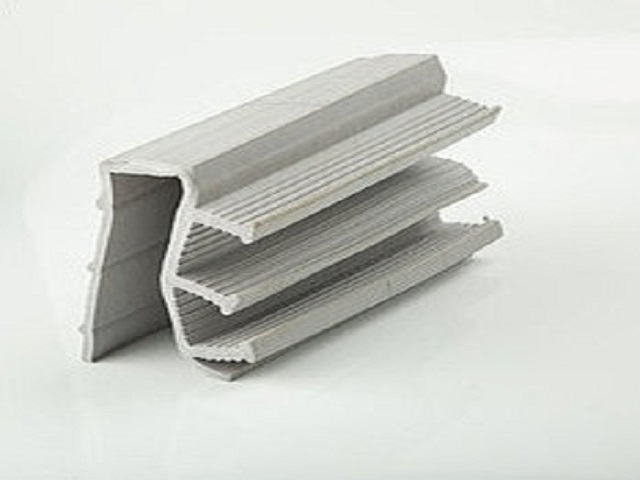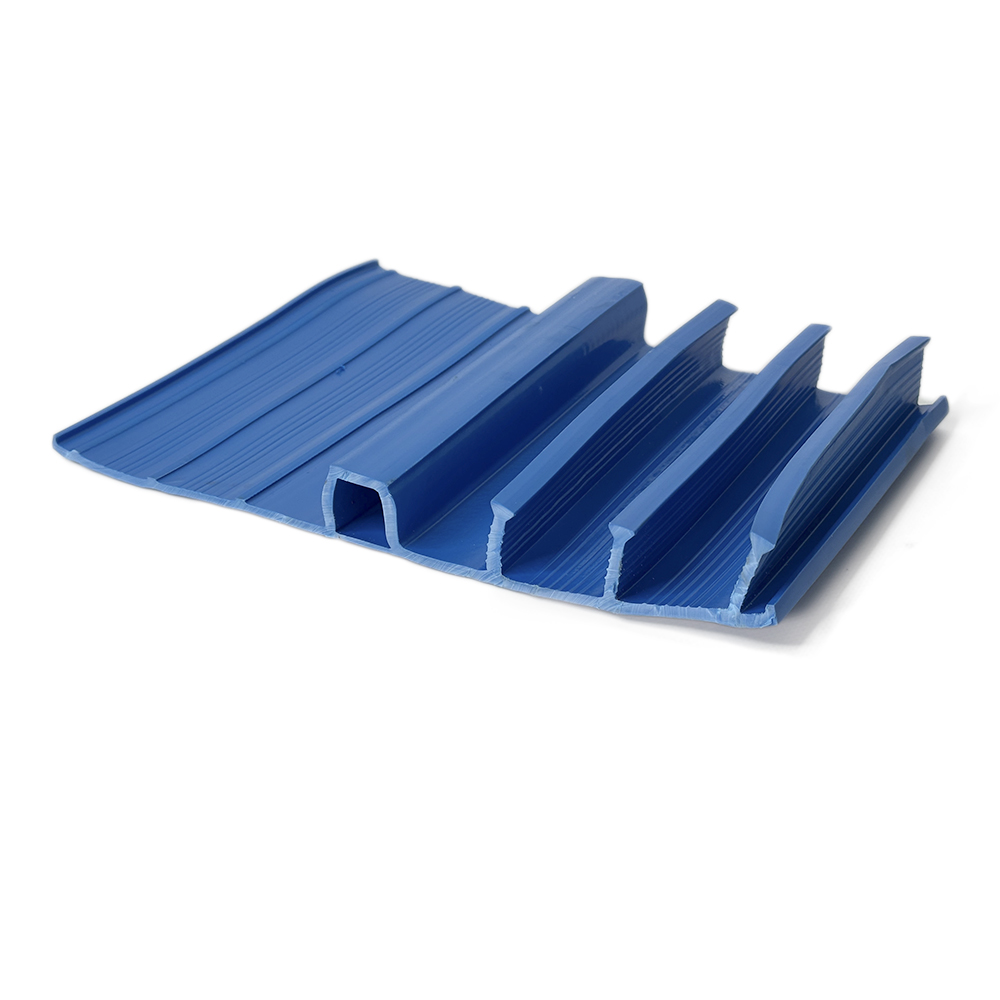Repair hydraulic gasket for expansion joints of the PO-3 series, bay 20 m
Product code: 0092
Repair hydraulic joint for expansion joints of the PO-3 series
572 uah
Repair hydraulic shutters of the PO-3 series are used for waterproofing expansion joints when mating with existing concrete structures. It is used in monolithic construction of buildings, including foundations, underground parking lots, tunnels, canals, etc. The repair hydraulic shingle is fixed to the existing concrete structure, the free part of the hydraulic shingle is loosened to the reinforcing frame of the poured structure, immediately before pouring concrete.

They are made of plasticized PVC-p polyvinyl chloride
Repair hydraulic valves of the PO-3 series are designed to seal the expansion joints between the finished w/b structure and the poured structure. The absence of fastening anchors on one side of the hydraulic shutter allows you to hermetically glue the U-shaped hydraulic shutter to the finished w/b structure. For reliable fixation of the hydraulic rod, a metal strip is used, which is fixed from the inside of the hydraulic rod with dowels. The U-shaped shape allows you to clearly install the hydraulic gasket in the design position using an elastic sheet material, for example, a styrofoam plate, on which the hydraulic gasket is "put on". The presence of ribs on the locking plane prevents moisture from entering the structure.
- it is used in the locations of deformation joints of monolithic reinforced concrete structures
- in particularly important structures, it is complemented by an internal or external repair hydraulic gasket
- they are supplied in bays of 20 m.p.
- If necessary, elongation and to perform spatial nodal transitions are welded in a conductor, with a construction hair dryer, flat TEN-ohms or glued together
| Материал | Пластифицированный поливинилхлорид (ПВХ-п) |
| Цвет | Серый |
| Упаковка | Рулоны по 20 м.п. |
| Отклонение длины рулона, м, не более | ± 0,5 |
| Отклонение размеров | Согласно КД |
| Твердость по Шору, А | 70 ± 5 |
| Плотность, г/см³ | ≈ 1,4 |
| Прочность при растяжении, МПа | ≥10 (DIN 53455) |
| Удлинение при разрыве, % | ≥ 275 |
| Термостойкость, °С | от -35°С до +70°С |
| Химическая стойкость | - от постоянного воздействия воды и сточных вод; - от кратковременного воздействия неорганических щелочей и кислот низкой концентрации, минеральных |
| Устойчивость к ультрафиолету | Не устойчив |
| Срок эксплуатации | не менее 25 лет |
Material : Plasticized polyvinyl chloride (PVC-p)
Color : Grey
Packaging : Rolls of 25 m.p.
Shore Hardness : A 70 ± 5 7
Density, g/cm3 ≈ 1.48
Tensile strength, MPa ≥10 (DIN 53455)
Elongation at break, % ≥ 275
Temperature resistance, °C from -35°C to 70°C 11
Chemical resistance:
- constant exposure to water and wastewater, benzenes and oils;
- from short-term exposure to inorganic alkalis and acids of low and medium concentration.
- from constant exposure to water and wastewater;
- from short-term exposure to inorganic alkalis and low concentration acids, mineral oils
UV resistance : not stable
Service life : at least 25 years old
Protex Hydroshonk PO-3, bay 20 m:
- Ensure reliable waterproofing of expansion joints with the help of the Protex series PO-3 repair hydraulic tamper.
- This product is ideal for reliable sealing of joints between existing concrete structures and new poured elements.
- The PO-3 hydraulic gasket, made of plasticized PVC-p polyvinyl chloride, provides a strong and airtight fixation to concrete structures.
- Thanks to the unique P-shape and the use of an elastic sheet material such as styrofoam, you will be able to clearly install the hydraulic shutter in the desired position.
- The use of the Protex PO-3 repair hydraulic gasket is especially recommended for the construction of buildings, foundations, underground parking lots, tunnels, canals and other structures where reliable waterproofing and tightness of joints are important.
- We offer bays of 20 meters each, which provides enough material for your projects.
- If it is necessary to lengthen the hydraulic rod or create complex spatial transitions, you can weld it in a conductor, use a construction hair dryer, a flat heating element or simply glue the sections.
- Do not leave gaps in the waterproofing and ensure the reliability of your structures with the Protex PO-3 repair hydraulic gasket.
- The hydraulic rod is installed in the design position, so that the middle of the hydraulic rod is located in the center of the deformation seam, with a smooth side, without anchors, the repair hydraulic rod is glued to the surface of the existing railway structure.
- For gluing, it is recommended to use Innoelast adhesive sealant based on a silane-modified polymer.
- For reliable fixation of the hydraulic shutter, a metal strip made of stainless steel 50x5 mm or aluminum 60x6 mm is used, which is fixed from the inside of the hydraulic shutter using dowels.
- For complete sealing, the dowels are installed on a sealant - fill the hole for the dowel with sealant before installing the dowel.
- The installation pitch of the dowels is 150 – 300 mm, chosen depending on the strength of the reinforced concrete structure and the expected water pressure.
- The U-shaped shape allows you to clearly install the hydraulic key into the design position using an elastic sheet material, for example, a styrofoam plate, on which a key is "put on".
- The sheet itself is fixed to the formwork and reinforcement frame so that the operated area of the hydraulic gasket turns out, after pouring, to be on the same level with a clean floor or slightly lower.
- The anchors of the hydraulic rod are fixed to the reinforcement frame using special clamps or knitting wire in increments of 300-500 mm.
- The connection of the key is made by welding, by heating the ends of the key in a special conductor (for each key there is an individual conductor) or using an industrial hair dryer or a flat heating element.
- The temperature of the spike is about 200 ° C (selected experimentally).
- To connect the dowels by the "cold" method, glue is used, for example, a one-component paste-like glue based on the silane-modified polymer Innoellast.
How do I connect a hydraulic gasket?
If necessary, elongation and to perform spatial nodal transitions are welded in a conductor, with a construction dryer, flat TEN-ohms or glued together
How do I connect a hydraulic gasket?
If necessary, elongation and to perform spatial nodal transitions are welded in a conductor, with a construction hair dryer, flat TEN-ohms or glued together
Related materials
Related materials
Internal hydraulic gasket for expansion joints VD 200, PVC, 20 m bay, blue
Internal hydraulic gasket for sealing and waterproofing of deformation movable joints VD 200, PVC, bay 20 m, blue color
Combined hydraulic gasket for working seams KAB-150, bay 25 meters
Combined hydraulic joint for working seams KAV-150
Internal hydraulic gasket for expansion joints VD 320, PVC, 20 m bay, blue
Internal hydraulic joint for expansion joints
Combined hydraulic gasket for working joints KAB-125, bay 25 meters
Combined hydraulic gasket for working joints KAV-125, bay 25m
Hydraulic joint PO-1 repair hydraulic joint for expansion joints , bay 20 m, gray
Repair hydraulic joint for expansion joints of the PO-1 series
Repair hydraulic gasket for expansion joints ND-R 200, PVC, bay 20 m, blue
Repair hydraulic joint for expansion joints
Hydraulic gasket internal hydraulic gasket for expansion joints VD 240, PVC, blue, bay 20 m
Hydraulic gasket internal hydraulic gasket for expansion joints VD 240, PVC, bay 20 m
© "Protex-S" LLC2021 | Website created by MD Design


